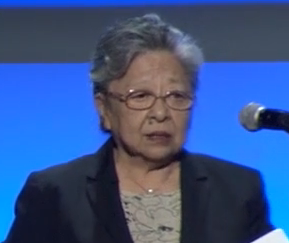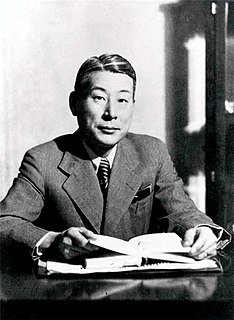 W
WBaron Sadao Araki was a general in the Imperial Japanese Army before and during World War II. As one of the principal nationalist right-wing political theorists in the Empire of Japan, he was regarded as the leader of the radical faction within the politicized Imperial Japanese Army and served as Minister of War under Prime Minister Inukai. He later served as Minister of Education during the Konoe and Hiranuma administrations. After World War II, he was convicted of war crimes and given a life sentence.
 W
WYukio Araki was a Japanese aviator of the Imperial Japanese Army during World War II. As a kamikaze pilot and member of the 72nd Shinbu Squadron, Araki's final mission took place on May 27, 1945 during the Battle of Okinawa when he flew his bomb-laden Mitsubishi Ki-51 to deliberately crash into the USS Braine. It is speculated that Araki and one other pilot are responsible for hitting the ship, killing 66 of its crew. At 17 years old, Araki is one of the youngest kamikaze pilots of World War II.
 W
WHachirō Arita was a Japanese politician and diplomat who served as the Minister for Foreign Affairs for three terms. He is believed to have originated the concept of the Greater East Asia Co-Prosperity Sphere.
 W
WHisanori Fujita was an admiral in the Imperial Japanese Navy. After retiring from active service, he served as the Chief Chamberlain of Japan and adviser to the Emperor of Japan during World War II.
 W
WSeiko Fujita , born Isamu Fujita , was a prominent Japanese martial artist, researcher and author. Regarded as the 14th and final heir to the Kōga-ryū Wada-ha Ninjutsu tradition, he was highly respected by his peers and a core member of Japan's classical martial arts community.
 W
WAiichirō Fujiyama was a Japanese politician of the Liberal Democratic Party and business executive.
 W
WKiichirō Hiranuma was a prominent pre–World War II right-wing Japanese politician and Prime Minister of Japan in 1939. He was convicted of war crimes and sentenced to life imprisonment.
 W
WHirohito was the 124th emperor of Japan according to the traditional order of succession. He reigned as the emperor of the Empire of Japan (大日本帝國) from 25 December 1926 until 2 May 1947 and of the state of Japan (日本国) from 3 May 1947 until his death on 7 January 1989. He was succeeded by his fifth child and eldest son, Akihito. Hirohito and his wife, Empress Kojun, had seven children, two sons and five daughters. In Japan, reigning emperors are known only as "the Emperor." He is now referred to primarily by his posthumous name, Shōwa (昭和), which is the name of the era coinciding with his reign; for this reason, he is also known as the Shōwa Emperor or Emperor Shōwa. By 1979, Hirohito was the only monarch in the world with the monarchical title "emperor." Hirohito was the longest-lived and longest-reigning historical Japanese emperor and one of the longest-reigning monarchs in the world.
 W
WNaoki Hoshino was a bureaucrat and politician who served in the Taishō and early Shōwa period Japanese government, and as an official in the Empire of Manchukuo.
 W
WPrince Kan'in Kotohito was the sixth head of a cadet branch of the Japanese imperial family, and a career army officer who served as Chief of the Imperial Japanese Army General Staff from 1931 to 1940.
 W
WToshikazu Kase was a Japanese civil servant and career diplomat. During World War II he was a high-ranking Foreign Ministry official. Hideaki Kase is his son and Yoko Ono is his niece.
 W
WTatsuo Kawai was a Japanese diplomat and author. He was a leading proponent of expansionism in Japan before World War II but later became a pacifist and was Japan's first Minister to Australia.
 W
WOkinori Kaya was the Minister of Finance of Japan between 1941 and 1944. In 1945, he was captured by the Allies, tried by the International Military Tribunal for the Far East and sentenced to twenty years imprisonment. Paroled in 1955, he later served as Minister of Justice from 1963 until 1964.
 W
WShunkichi Kikuchi was a Japanese photographer best known for his documentation of Hiroshima and Tokyo immediately after the war.
 W
WNobusuke Kishi was a Japanese politician who was Prime Minister of Japan from 1957 to 1960. He is the maternal grandfather of Shinzo Abe, twice prime minister from 2006 to 2007 and 2012 to 2020.
 W
WKoko Tanimoto is a prominent atomic bomb survivor, and is the daughter of Kiyoshi Tanimoto, a Methodist minister famous for his work for the Hiroshima Maidens. Both appear in John Hersey's book, Hiroshima.
 W
WPrince Fumimaro Konoe was a Japanese politician and Prime Minister who presided over Japan's invasion of China in 1937 and the deterioration in relations with the United States and its allies. He also played a central role in Japan's transformation into a totalitarian state by passing the National Mobilization Law and founding the Imperial Rule Assistance Association.
 W
WCommander Shunsaku Kudō was an officer in the Imperial Japanese Navy. He is notable for the humanitarian act of rescuing 442 enemy British and American sailors from the Java Sea in 1942.
 W
WSaburō Kurusu was a Japanese career diplomat. He is remembered now as an envoy who tried to negotiate peace and understanding with the United States while the Japanese government under Hideki Tojo was secretly preparing the attack on Pearl Harbor.
 W
WShōzō Murata was a Japanese entrepreneur, cabinet minister and diplomat before, during and after World War II.
 W
WSaitō Takao was a Japanese politician and longtime member of the Imperial Diet from Hyōgo Prefecture. He was a member of the Rikken Minseito party. On February 2, 1940, he made a speech in which he sharply questioned the prosecution and justification of Japan's "holy war" in China. For this, he was expelled from the Diet on March 7, 1940. His speech also led to the creation of the League of Diet Members Believing the Objectives of the Holy War by Fumimaro Konoe. Saitō would be re-elected to the Diet in 1942. After the surrender of Japan in 1945, he was one of the politicians that participated in the Allied Occupation's efforts to democratize Japan.
 W
WMamoru Shigemitsu was a Japanese diplomat and politician in the Empire of Japan, who served as the Japanese Minister of Foreign Affairs at the end of World War II and later, as the Deputy Prime Minister of Japan.
 W
WChiune Sugihara was a Japanese diplomat who served as vice-consul for the Japanese Empire in Kaunas, Lithuania. During the Second World War, Sugihara helped about 6,000 Jews flee Europe by issuing transit visas to them so that they could travel through Japanese territory, risking his job and the lives of his family. The fleeing Jews were refugees from German-occupied Western Poland and Soviet-occupied Eastern Poland, as well as residents of Lithuania. In 1985, the State of Israel honored Sugihara as one of the Righteous Among the Nations for his actions. He is the only Japanese national to have been so honored. The year 2020 is "The Year of Chiune Sugihara" in Lithuania. It has been estimated as many as 100,000 people alive today are the descendants of the recipients of Sugihara visas.
 W
WKiyoshi Tanimoto was a Methodist minister famous for his work for the Hiroshima Maidens. He was one of the six Hiroshima survivors whose experiences of the bomb and later life are portrayed in John Hersey's book Hiroshima.
 W
WShigenori Tōgō was Minister of Foreign Affairs for the Empire of Japan at both the start and the end of the Axis–Allied conflict during World War II. He also served as Minister of Colonial Affairs in 1941, and assumed the same position, renamed the Minister for Greater East Asia, in 1945.
 W
WHideki Tojo was a Japanese politician and general of the Imperial Japanese Army (IJA) who served as Prime Minister of Japan and President of the Imperial Rule Assistance Association for most of World War II.
 W
WTokyo Rose was a name given by Allied troops in the South Pacific during World War II to all female English-speaking radio broadcasters of Japanese propaganda. The programs were broadcast in the South Pacific and North America to demoralize Allied forces abroad and their families at home by emphasizing troops' wartime difficulties and military losses. Several female broadcasters operated using different aliases and in different cities throughout the Empire, including Tokyo, Manila, and Shanghai. The name "Tokyo Rose" was never actually used by any Japanese broadcaster, but it first appeared in U.S. newspapers in the context of these radio programs during 1943.
 W
WKenkichi Yoshizawa was a Japanese diplomat in the Empire of Japan, serving as 46th Foreign Minister of Japan in 1932. He was the maternal grandfather of Sadako Ogata, the former United Nations High Commissioner for Refugees from 1991–2001.